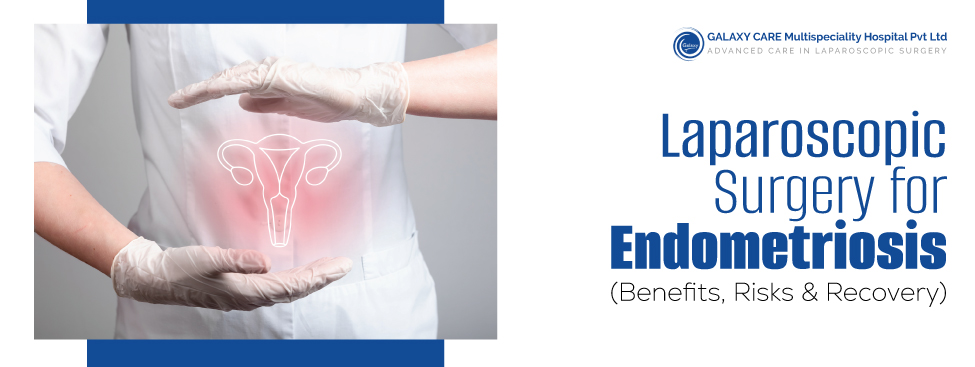
Laparoscopic Surgery for Endometriosis: Benefits, Risks & Recovery
Getting diagnosed with endometriosis can feel overwhelming—and let’s be honest, figuring out the next steps isn’t always easy. Maybe you’ve already tried medications or other treatments, and now surgery is on the table. If that sounds familiar, you’re definitely not alone. So many women go through this same journey, and it’s completely okay to have questions or feel unsure.
At Galaxy Care Hospital, we are a renowned centre for Lap gynae surgery in Pune. Let us help you break down what endometriosis really is, what laparoscopic gynac (minimally invasive) surgery involves, the pros, the risks, and what recovery might look like. Let’s take a closer look at how laparoscopic gynecology surgery could be the right treatment for endometriosis.
What is Endometriosis?
Endometriosis is a chronic and often painful condition, usually during their reproductive years. It occurs when tissue similar to the lining inside the uterus (the endometrium) starts to grow outside your uterus—most commonly on the ovaries, fallopian tubes, and pelvic lining. This tissue behaves just like the endometrial lining: it thickens, breaks down, and sheds with each menstrual cycle. However, because it has no way to exit your body, it becomes trapped, leading to inflammation, scar tissue, adhesions, and cysts.
The symptoms of endometriosis vary from person to person. The most common ones include intense pelvic pain (especially during periods), excessive bleeding, pain during or after sexual intercourse, painful urination or bowel movements, fatigue, digestive problems, and even infertility. Some women have mild symptoms, while others may have severe pain or difficulty getting pregnant. The unpredictability and invisibility of endometriosis can heavily impact daily life—not just physically, but emotionally as well. Diagnosis is often delayed, with many women waiting years to find answers.
Why Consider Surgery for Endometriosis?
Treatment for endometriosis aims to relieve symptoms, control the disease, and improve quality of life. Initial steps often include pain relief medication and hormone therapy. However, these options provide only temporary relief and do not resolve severe endometriotic lesions or adhesions. Sometimes, symptoms persist or worsen despite these treatments, or fertility becomes a major concern. In these cases, surgery is recommended to diagnose and treat the condition more effectively.
Traditionally, open abdominal surgery was the only choice, involving large incisions and prolonged recovery. Today, advances in technology have made lap gynae surgery– the preferred option due to its minimally invasive nature.
What is Laparoscopic Surgery for Endometriosis?
Lap gynae surgery for endometriosis is a minimally invasive surgical procedure performed using small incisions in the abdomen. Through these tiny incisions, a laparoscope (a thin tube with a camera and light) and specialized surgical instruments are inserted, allowing surgeons to see inside your pelvic area on high-definition monitors.
During the procedure, the surgeon can precisely locate and remove (excise) or destroy (ablate) endometriotic implants, cysts, and adhesions without having to make a large incision. The advantages here are twofold: accurate diagnosis (since endometriosis may not always be visible on imaging scans) and effective removal of diseased tissue, which offers significant relief from symptoms and improves fertility for those trying to conceive.
Benefits of Lap Gynae Surgery for Endometriosis
- Minimal Invasion, Maximum Effect: Since lap gynae surgery requires only small cuts, there is much less trauma to the body compared to traditional open surgery. This means less pain, reduced blood loss, and minimal scarring.
- Faster Recovery: Patients who undergo laparoscopic surgery for endometriosis typically recover more quickly and can return to their daily activities and work sooner—often within a few days to a week.
- Enhanced Visualization: The advanced camera systems used in lap gynae surgery provide magnified, high-definition views of even the tiniest endometriotic lesions. This helps surgeons remove or treat the problematic tissue precisely while sparing healthy organs.
- Reduced Hospital Stay: Most laparoscopic surgeries are performed as day-care procedures or with a much shorter hospital stay, reducing your overall disruption and healthcare costs.
- Lower Risk of Complications: Smaller incisions also mean a lower risk of wound infections, hernias, and other complications that can occur after abdominal surgery.
- Better Fertility Outcomes: For women who want to start or expand their families, laparoscopic removal of endometriosis can significantly improve fertility chances, especially when treating ovarian cysts or restoring normal pelvic anatomy.
Risks & Considerations
No surgery is completely risk-free. While lap gynae surgery is generally very safe in experienced hands, it’s important to be aware of potential risks:
- Infection or Bleeding: As with any surgery, there is a small risk of infection or bleeding.
- Damage to Surrounding Organs: Rarely, organs close to the uterus and ovaries, such as the bladder, bowel, or ureters, may be injured during surgery.
- Adhesion Formation: Sometimes new scar tissue can form after surgery, though laparoscopic techniques greatly reduce this risk compared to open surgery.
- Incomplete Symptom Relief: Not all patients experience complete relief from pain, as endometriosis can be complex; sometimes, additional treatment is required.
- Conversion to Open Surgery: In very rare cases, if laparoscopy isn’t sufficient, conversion to open surgery may be necessary.
Before surgery, your lap gynac surgeon will discuss these risks in detail based on your specific situation, complete medical evaluation, and imaging studies.
Recovery After Laparoscopic Surgery for Endometriosis
Another major advantage of lap gynae surgery is smoother, faster recovery. After surgery, you’ll be monitored for a few hours or overnight, depending on how you’re feeling and the extent of surgery performed.
- Pain Management: Most patients experience mild to moderate pain at incision sites, easily managed by painkillers.
- Early Mobilization: Gentle movement is encouraged soon after surgery to reduce the risk of blood clots and speed up your healing.
- Return to Normal Activities: Most women return to light office work or routine activities within a week. Strenuous exercise or heavy lifting should be avoided for about 2-4 weeks.
- Follow-Up: Your healthcare provider will schedule follow-ups to assess healing, address questions, and discuss ongoing management if needed.
Emotional recovery is equally important. Many women feel relieved to be free from chronic pain, while others may need time to adjust and process their experience. Support from friends, family, or endometriosis support groups can be extremely helpful during this period.
Why Choose Galaxy Care Hospital for Your Lap Gynae Surgery?
Endometriosis can take a toll on every aspect of life—but the right treatment, delivered with skill and compassion, can make all the difference. Choosing where to have your lap gynae surgery is one of the most important parts of your health journey. At Galaxy Care Hospital, we offer world-class expertise with genuine compassion and understanding. Our hospital is equipped with state-of-the-art operation theatres featuring the latest laparoscopy equipment, advanced imaging, and laparoscopic surgery OTs under one roof.
We understand that needing surgery can be overwhelming. That’s why our team focuses not just on medical excellence, but also on providing personalized, compassionate care. From your first consultation to post-surgical recovery, you’ll be supported at every step by experienced gynaecologists and a caring nursing staff. Our modern intensive care units, varied accommodation options, and patient-centred approach ensure safety, comfort, and peace of mind during your treatment and recovery. Reach out to us today and take the next step towards reclaiming your well-being.


